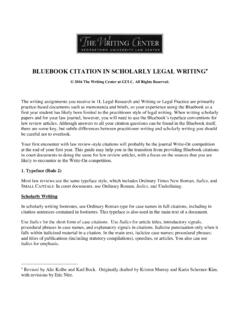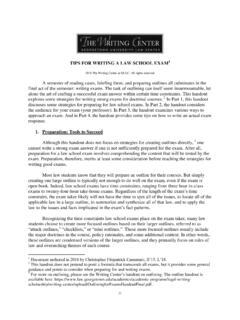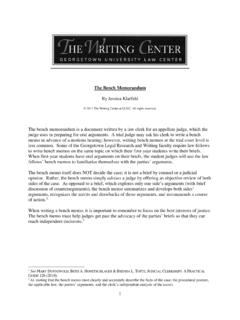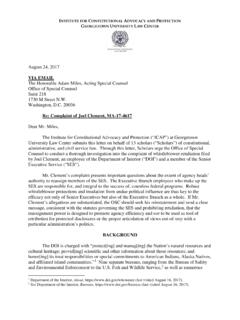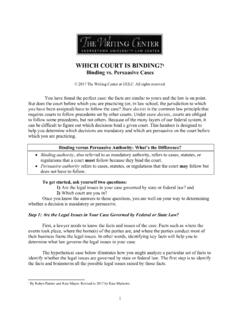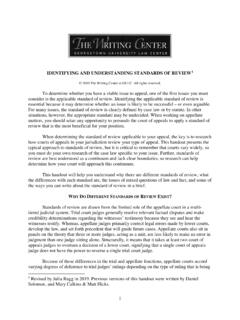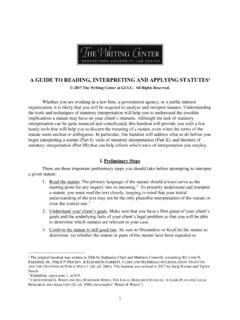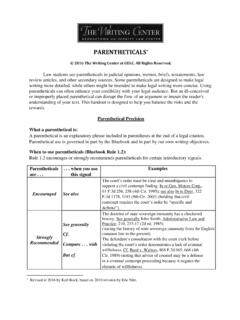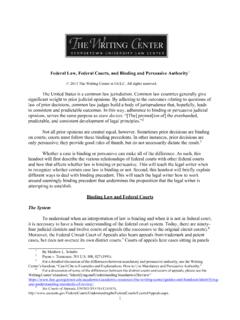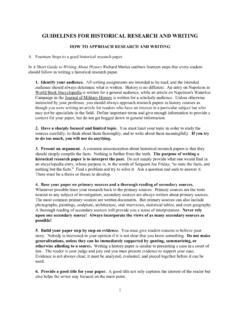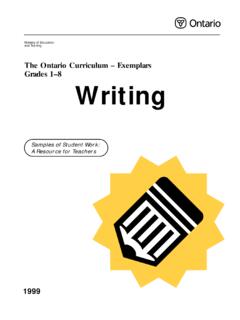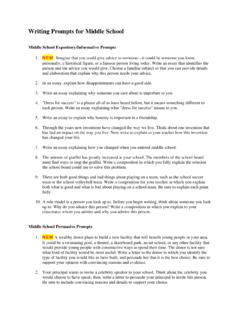Transcription of WRITING THE STATEMENT OF THE CASE IN AN APPELLATE …
1 1 WRITING THE STATEMENT OF THE CASE IN AN APPELLATE BRIEF1 2020 The WRITING Center at All rights reserved. Every component of an APPELLATE brief is an opportunity to persuade the reader, and the STATEMENT of the Case is no exception. The STATEMENT of the Case (sometimes called the STATEMENT of Facts ) should convey to the reader a persuasive narrative about the factual scenario surrounding the legal action. Crafting this narrative in a brief requires a somewhat different approach than in a memo. Unlike a legal memo, in which the reader will expect an objective recounting of the factual background, an APPELLATE brief will typically seek to present the facts in a way that is advantageous to the client.
2 But this is not to say that the STATEMENT of the Case should be disingenuous, untruthful, or dismissive of unfavorable facts. Remember that judges will have read both the lower court s and opposing counsel s description of the facts. If your version of events is dramatically different from these sources, you may lose credibility. An APPELLATE brief should provide the judges with everything they need to write an opinion in your client s favor. Therefore, striking the right balance between persuasive advocacy and credibility is crucial. (1) THEORY OF THE CASE: THE PERSUASIVE FOUNDATION Incorporating your Theory of the Case. The Theory of the Case is the unifying theme of your client s case.
3 While the facts explain what happened and the law explains the legal implications of those events, the Theory of the Case should act as an implicit message throughout the brief that helps the reader empathize with your client s case. For example, if you are representing a party injured in a car accident, your legal theory might be that the other driver was negligent, but your Theory of the Case might be that the driver was in a rush. In your STATEMENT of the Case, you will want to highlight facts supporting your Theory of the Case the driver was speeding, late for an appointment, attempting to weave through traffic, etc. 1 This handout is designed to complement the WRITING Center handout titled, From Memo to APPELLATE Brief.
4 2 Original handout prepared by Brooke Rowland (2014). Revised by John Donnelly and Perry Cao (2020). 2 WRITING an effective STATEMENT of the Case without a clear understanding of your Theory of the Case can be difficult. Therefore, many writers find it helpful to write the STATEMENT of the Case with an objective framing at first. After firmly establishing a Theory of the Case (often through WRITING the Argument portion of the brief), you can then begin editing the STATEMENT of the Case to reflect that theory and your overall persuasive narrative . Utilize the STATEMENT of the Case to shape the reader s opinion of the correct outcome. The most effective briefs will convince a reader before even reaching the Argument.
5 Incorporating themes and details that make your client more likeable or their actions more understandable will help achieve this goal. o For example, if your client committed a crime, emphasize anything that would make such a decision seem more excusable or relatable Was he provoked? Was he trying to protect himself? Was he trying to provide for his family? (2) BUILDING THE BASIC narrative Where you start the story matters. It often makes sense to tell a story chronologically. Nonetheless, a strictly chronological recitation is not always the most persuasive. You may also want to frame the facts in the context that places your client in the most favorable light. What do you want the reader to focus on?
6 If the opposing side is especially unlikeable, you might lead with facts that illustrate this. If your client is the good guy, do not make your reader wait until the end of your STATEMENT of the Case to find out. For example: Mr. Smith, who had previously been convicted for tax fraud, stole three televisions from an electronics store on the evening of March 3rd. Starting the sentence with negative information automatically associates the subject with wrongdoing. Include all legally relevant facts, even if they do not favor your client. Leaving out key facts undermines your credibility, can make the Argument section confusing, and may violate the Rules of Professional Responsibility. If you discuss a fact anywhere in your legal analysis, it must be in the STATEMENT of the Case.
7 When you fail to include facts that disfavor your client, you lose the opportunity to frame that negative fact which will inevitably surface in the opposing counsel s brief in a way that is less damaging. Ignoring a harmful fact does not make it go away; it simply leaves the problem unexplained and undefended. Cases are rarely one-sided, meaning that you will inevitably have to grapple with negative facts. The best way to advocate for your client is to paint these negative facts in the best possible light and frame the narrative to your advantage. Don t be afraid to include non-legally significant facts if they help your client s narrative . Do not deceptively characterize the facts. There is a key difference between strategic framing and blatant misrepresentation.
8 Deceptive characterizations damage your credibility. Accurately 3 state the facts in a way that most favors your client, but do not try to make the STATEMENT of the Case persuasive by being dishonest or deceitful. The STATEMENT of the Case should not appear biased or overdramatic. Perceived bias and exaggeration can damage your credibility and make the reader less inclined to take your representations at face value. Your job is to tell a story, not write a novel. Vivid language can guide your reader through the narrative more effectively but should be used strategically. If the STATEMENT of the Case becomes too dramatic, readers and judges will not take it seriously. Not: Sarah Parker, a moral and upstanding citizen, first met the defendant, Jacob Smith a suspicious and manipulative real estate agent at a networking reception.
9 Use a subtler approach one that will lead your reader to the desired conclusion without alerting the reader that this is happening. You can include and frame certain facts such that the reader independently starts viewing the opposing party in the way you want. Bring the reader to this point organically, but do not say it outright. Instead: The defendant, Jacob Smith, met Sarah Parker at a networking reception in early July. The following week, Smith began attempting to track Parker s financial activity. After about a month of monitoring, the defendant encouraged Parker to attend an open house for a property that Smith knew to be out of her price range. Portray your client s position as the default.
10 When possible, try to insinuate that your client s positions or actions are the default. This is best illustrated by an example: If your client is being sued for parking in a restricted area, instead of WRITING individuals are prohibited from parking in this area, [list exceptions], you could write individuals are allowed to park in the area, [list restrictions]. By framing the sentence permissively, you alter the reader s perspective. The reverse is also true: you can frame the opposing party s conduct restrictively to make their behavior seem anomalous. Importantly, this is simply a matter of strategic framing avoid making legal conclusions or arguments in the STATEMENT of the Case.
